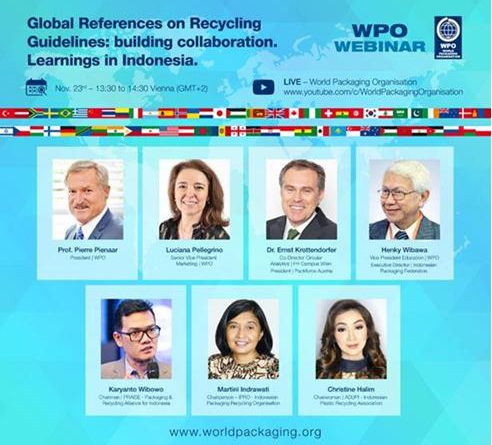WPO develops a ‘National Recycling Framework’ to Indonesia
In March 2020, Packforce Austria, appealed to the World Packaging Organisation (WPO) to take the leadership in tackling the global packaging waste issue in a more practical and measurable way. “We agreed that much was being taught and spoken about on this global challenge, but there was a way to go still in the implementation of international standards and responsibilities”, remembers Pierre Pienaar, WPO President. The region chosen for a pilot program was Indonesia where it is evident that packaging waste is a major problem.
The first local body invited to be part of the project was another WPO member, Indonesian Packaging Federation (IPF). “IPF was more than willing to embark on this project and help creating a pilot program to introduce a national recycling framework for Indonesia”, celebrates its Executive Director, Henky Wibaya that is also WPO Vice President Education. Another key national player approached for this project, the Packaging and Recycling Alliance for Indonesian Sustainable Environment (PRAISE). Through PRAISE, the program also counted with the commitment of international brand owners and packaging converters like Coca Cola, Nestle, Unilever, Danone, Indofoods and Tetra Pak.
The result, after 18 months of weekly meetings, has been the implementation of ‘Indonesian Recycling Design Guidelines’, in October 2021. The project was handed over to the newly-created Indonesian Packaging Recycling Organisation (IPRO). The second outflow of the project is the formation and completion of the first edition of the ‘Packaging Design for Recycling Guide’, which the WPO delivered to all members on 4 October 2021. “The beauty of this project is that these guidelines can be implemented in a country with the necessary local specific applications being added”, celebrates Pierre Pienaar.
On November 23, at 1:30 pm (CEST), during the second meeting of 2021, WPO will offer its members and key national players (manufacturers, recyclers, brand owners) an opportunity to know the project in details through a virtual and free webinar with the participation of the Indonesian stakeholders. At this occasion, participants will also discuss plans and actions to implement future packaging circular business model. The webinar will be transmitted live in WPO YouTube channel – https://youtube.com/c/WorldPackagingOrganisation – and questions can be done by chat.
Understanding the ‘Packaging Design for Recycling Guide’
Design for recycling is part of circular product design and represents an important basis for holistic sustainability assessment. Accordingly, circularity means that the packaging is designed in such a way that the highest possible recycling of the materials in use can be achieved. The goals here are resource conservation, the longest possible service life, material-identical recycling (closed-loop recycling) or the use of renewable materials. Circular packaging should therefore be designed and manufactured in such a way that it can be reused (reusable solution) and/or that the raw materials used can be reused to a large extent as secondary raw materialsafter the use phase (recycling) and/or consist of renewable raw materials. In order to be able to apply recyclable packaging design, a certain fundamental knowledge of sorting and recycling processes is necessary. Packaging must, therefore, be suitable for state-of-the-art sorting and recycling processes in addition to its basic functions (e.g., storage, transport, product protection, product presentation and convenience).
The Packaging Design for Recycling Guide is a starting point to understand Best Practice examples using state-of-the-art technology that can then be applied and tailored to suit the recovery and recyclability capabilities and infrastructure on a regional and local level. The guide can be applied to products from the Food, Near-Food and Non-Food segments and is applicable to all primary, secondary and tertiary packaging; provided that product-specific regulations of the packaging system are observed.

